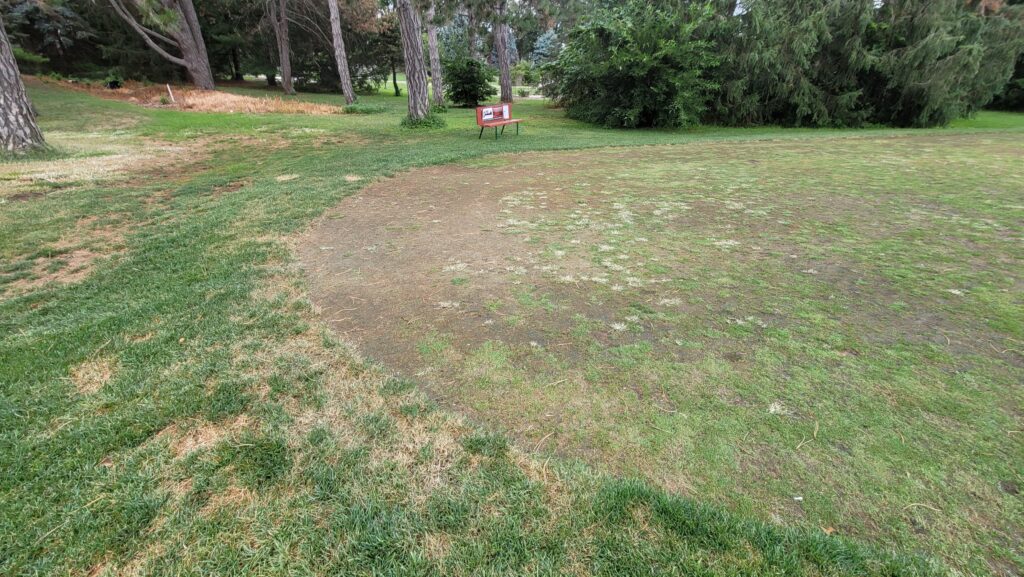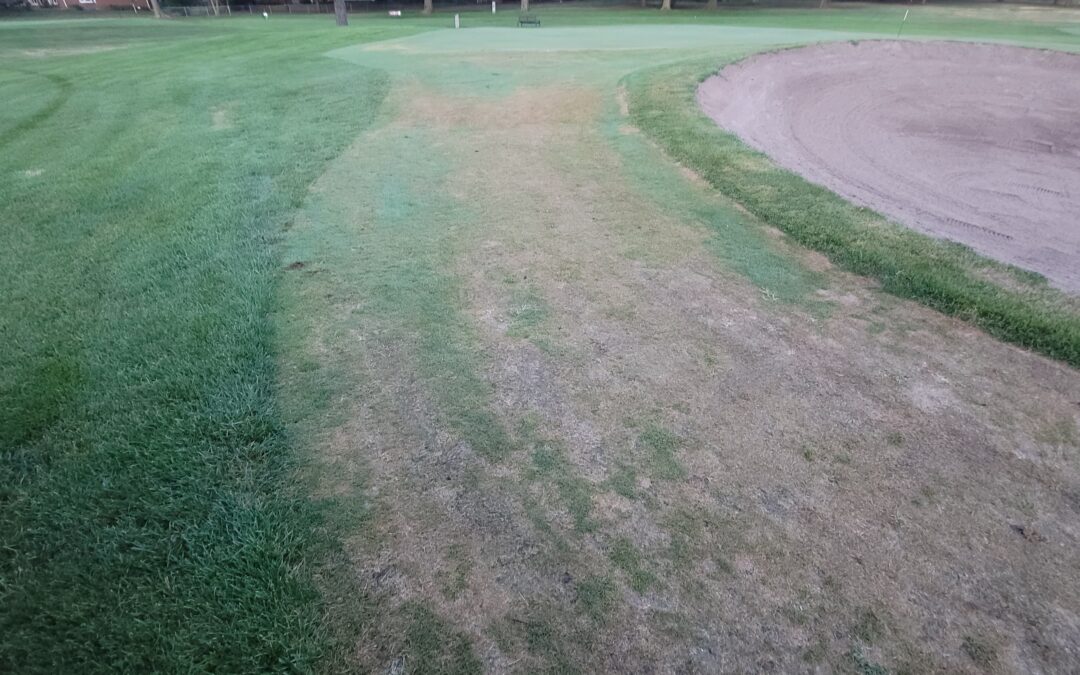It’s mid-August 2022 and many turfgrass managers feel as tired as their grasses. The sun is slower to rise, the shadows are starting to lengthen, and it’s more difficult for me to pop out of bed when my alarm clock sounds. The weather has been brutal across much of the US this summer. Drought in the west and Great Plains, excessive rainfall out east, and record breaking heat across much of the county have made for a tough July and early-August. While these conditions are hard on humans, they can be literally impossible for cool-season grasses.
The saying “the dose makes the poison” can be applied to most abiotic turf stresses. For example, many cool-season grasses can tolerate weather extremes – hot, cold, wet, or dry – when they are short-lived. Add some pre-conditioning (i.e. minor drought in late-May) and our grasses can become even more resilient to extremes. When Mother Nature plays the long-game however, turf decline and death can be inevitable.
Sugar Levels
Plants are great because they make their own food through photosynthesis. These carbohydrates, or sugars, are used to build plant structures like roots, shoots, stems, and seeds. They also can be stored in complex chains and burned later to provide the plant energy at night or during stressful growing conditions. The more carbohydrates that are stored in the plant, the healthier the plant.
Many turf managers assess carbohydrate storage by examining root mass and length. While this isn’t a perfect correlation, it can be an easy representation of carb storage levels. It’s why many managers and golf course superintendents focus so intently on roots and they are willing to use different plant health products to sustain and promote root mass. While some products can help sustain root mass (i.e. products containing the hormone cytokinin), “rooting” doesn’t guarantee a healthy plant. It takes energy to sustain and increase root mass and that energy needs to come from other parts of the turf plant (leaves, crowns, stems). The best way to maximize carbohydrate storage and root mass is to manage sugar burn during summer.
Calories in versus Calories Out
The ideal air temperature to maximize photosynthesis for cool-season grasses is around 68F (20C) and 86F (30C) for warm-season turfgrass species. When temperatures diverge from these ideal temperatures, sugar production slows. PACE Turf has been promoting this concept through their description of growth potential for years (https://www.paceturf.org/PTRI/Documents/0401ref01.pdf). Their growth potential provides a nice metric to visualize sugar production. Sugar is then burned through respiration to drive healthy growth and development. Respiration is also related to temperature. It increases as air/leaf/soil temperature increases.

When sugar production outpaces sugar burn on a given day, then the sugar reserves in the plant will increase. When the sugar burn rate outpaces sugar production, then reserve levels decline. Think of it like dieting and exercise to lose weight. To lose weight, consume fewer calories through dieting and increase metabolism through exercise to burn calories quicker. During chronic heat stress in cool-season grasses, photosynthesis (calories in) declines and sugar burn (calories out) increases. This causes sugar reserves to decline. If this extreme diet and exercise program continues, then cool-season grass species will being to thin and the stand will eventual collapse.
Getting Closer to the Edge
Don’t think that everything is perfect at the golf course I maintain in Lincoln, NE. It is mid-August and every mis-step is highly apparent. When sugar levels are normal, the turfgrass can quickly recover from wilt, herbicide injury, traffic, etc. But when sugar levels decline, recovery can be impossible. There isn’t enough sugar to build new plant tissue. Even when managers do things perfectly, additional heat stress, increasing shade stress in late summer, and normal traffic from carts/golfers/maintenance can led to rapid thinning and stand collapse.
I made light rate applications of the herbicide topramezone to control warm-season weedy grass species on creeping bentgrass collars and greens. These weeds are a constant problem at our course and it’s always a tough decision: watch collars get covered in a lawn of goosegrass and crabgrass or watch bentgrass turn white. The application in mid-July was normal: light colored bentgrass and white weeds. It was very hot that week, but the weeds died and the bentgrass recovered. Two weeks later, I treated some additional areas for goosegrass at a lower rate. There was a temporary break from the heat when the topramezone was applied. The application killed the weeds, but it also caused severe damage to the bentgrass.


So what was the difference? Was the herbicide more phytotoxic during cooler weather? That probably was not the case. It is more an indication of low sugar levels in that bentgrass during early August. The pigment inhibiting herbicide limits sugar production and can increase oxidative stress. The combination of stress in early August, when sugar levels are low, proved to be too much for the bentgrass. Similar examples can be seen where the shadows are lengthening which limits photosynthesis, or where traffic from golfers/maintenance/carts is taking a toll on collars. Other species like annual bluegrass (photos below) are also starting to check out as their sugar levels plummet under the heat stress and reduced photosynthetic efficiency.



Playing the long game
Ideally, turfgrass growth rate would be closely aligned with sugar production. Unfortunately, that isn’t always the case. Growth rate, more specifically clipping production, is incredibly responsive to different environmental stimuli (light quality/shade, water access, nitrogen availability, etc.) and plant management (mowing height & frequency, cultivation practices, etc.).
In GreenKeeper App, we display the PACE Turf Growth Potential and Nitrogen Response Potential in addition to tracking of clipping volume. These metrics help users understand if the plant is winning or losing the sugar production game each day. The PACE model helps users understand how much sugar is being produced. The Nitrogen Response Potential shows how grasses are likely to respond to nitrogen in the soil from fertilizer applications or soil mineralization. I’ve written about these different models in this past blog post. These two models are not exactly aligned in all cases. When clipping yield response to nitrogen is high and/or ClipVol is high and PACE GP is low, sugar levels can rapidly decline. This may be fine for a few days, but over weeks to months can be devastating.
Managing Sugar Levels in Late Summer
Here are some tips to stretch plant carbohydrate reserves through late summer:
- Carefully manage growth rate: Avoid practices that will stimulate excessive clipping volume until daily average air temperatures return to the peak PACE Growth Potential range (roughly 68F and 86F for cool- or warm-season species). Use light applications of N fertilizer only if needed. Soil microbes generally provide the turf with adequate (or above-adequate) nitrogen at Ager Golf Course recently. If clipping volume levels are too low, consider reducing the PGRs instead of increasing N fertilizer.
- Do no harm: I’m guilty here. It is easy to do too much cultivation or use a pesticide that can damage the turf this time of year. Even plant health products can sometimes cause serious problems in late summer. Keep the turf on the dry side, but avoid wilt. When sugar levels are low, it can be difficult to impossible for the grass plants to recover from that stress.
- PGRs can help control sugar burn: When soil N levels are high in late summer, ClipVol can quickly spike. This will rapidly deplete sugar reserves during high temperatures. PGR applications can help here by squashing that extra growth. Mixtures of Class A & B PGRs can have an additive effect and slow clipping production more than a single AI application. Use GreenKeeper App to schedule PGR applications. Read more in a past blog article. Class A PGRs also can reduce plant respiration rate. This means the plant will burn sugar at a slower rate during the late-summer heat.
- Maximize photosynthesis: Prune any tree limbs that are limiting light as the sun angles decline through the fall. Ensure the plant has access to water to maximize photosynthetic potential and transpiration for cooling. If turf has iron chlorosis from the warm/wet soils, apply low rates of iron fertilizer to maximize light capture by the leaves.
- Raise mowing heights: This increases leaf area and increases net photosynthesis. Our research has shown that lowering mowing heights at greens/tees/fairway height actually increases clipping production. This taxes sugar production and reallocates carbohydrates for other plant tissues (roots, crowns, carbohydrate reserves). Raising mowing heights will slow #ClipVol and conserve carbohydrates.
Conclusions
You’re not the only one feeling tired this time of year. The cool-season grass species can be at dangerously low sugar levels from the high heat. Try to control growth rate to conserve plant carbohydrate stores with higher mowing heights, PGRs, and limit practices that can be tough on the grass plants. Sign-up for a free 7-Day GreenKeeper App trial (no credit card required) to schedule and visualize your PGR program. Fall-like temperatures are in the forecast for the Great Plains and Eastern US. This will provide great weather for the plant to start making more sugar and start recovering from the stress and heat of 2022.


Very good información thanks so much